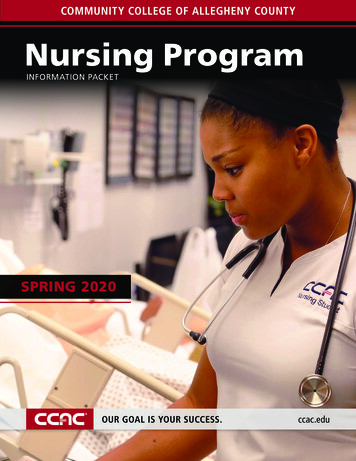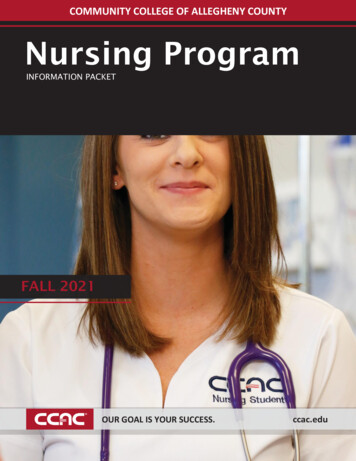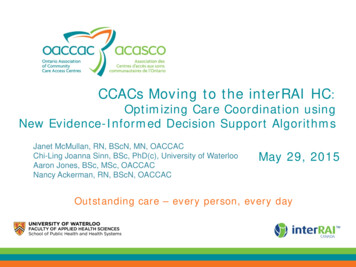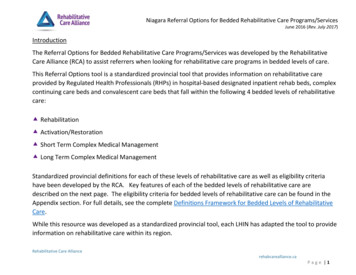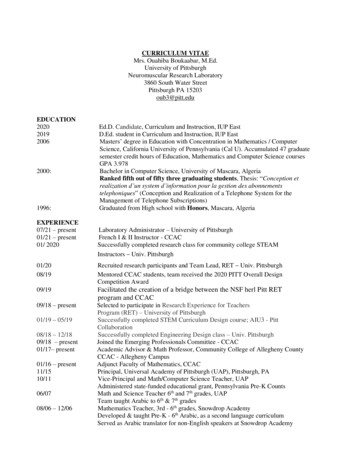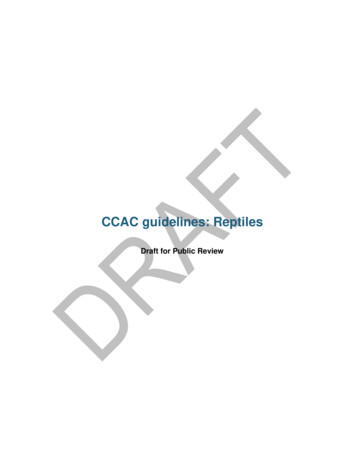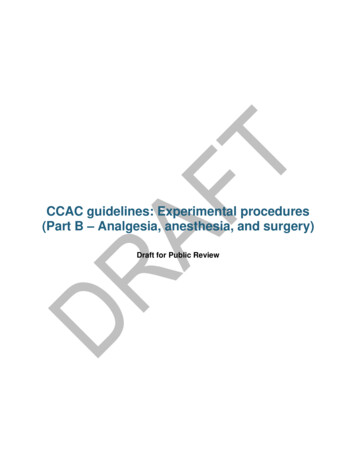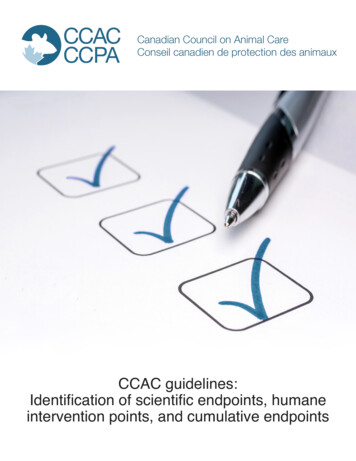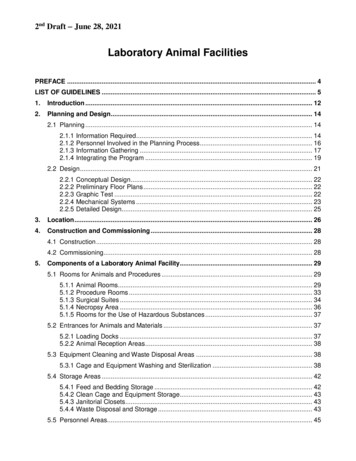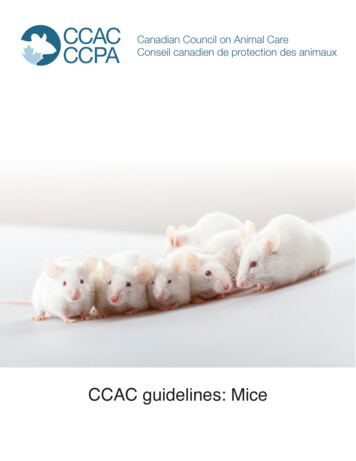
Transcription
Canadian Council on Animal CareConseil canadien de protection des animauxCCAC guidelines: Mice
Date of Publication: August 2019 Canadian Council on Animal Care, 2019ISBN: 978-0-919087-77-4Canadian Council on Animal Care190 O’Connor St., Suite 800Ottawa, Ontario, K2P 2R3http://www.ccac.ca
ACKNOWLEDGEMENTSThe Canadian Council on Animal Care (CCAC) Board of Directors is grateful for the expertise contributedby the members of the CCAC Mice Subcommittee and for their engagement throughout the guidelinesdevelopment process. In addition, the Board is grateful to all those who provided critical input during thetwo review periods. We would also like to acknowledge the contributions of both the CCAC StandardsCommittee and the CCAC Assessment and Certification Committee members, who provided importantguidance to the subcommittee. Finally, we would like to thank the CCAC Secretariat project team for itsexcellent work throughout this process.The CCAC also acknowledges its funders, the Canadian Institutes of Health Research and the NaturalScience and Engineering Research Council of Canada. The CCAC could not continue to deliver on its current mandate without their generous support.Dr. Eileen Denovan-WrightChair, CCAC Board of DirectorsMr. Pierre VerreaultCCAC Executive DirectorCCAC MICE SUBCOMMITTEEDr. Tamara Godbey (Chair)Dr. Robert Gendron, Memorial UniversityDr. Hélène Héon, Centre de recherche du Centre hospitalier de l'Université de MontréalDr. Patricia Turner, Charles River LaboratoriesDr. René St-Arnaud, McGill UniversityMs. Evelina SmithEXTERNAL REVIEWERSThe document incorporates comments received during two review periods. Eighteen reviewers from nine different academic, government, and private sector organizations across Canada and five international reviewersparticipated in the first review, and thirteen reviewers from twelve different institutions across Canada andone international reviewer participated in the second review. One individual participated in both reviews.
CCAC STANDARDS COMMITTEEDr. Stan Boutin, University of AlbertaDr. Philip Byrne, Fisheries and Oceans CanadaDr. Eileen Denovan-Wright, Dalhousie UniversityDr. Nicolas Devillers, Agriculture and Agri-Food CanadaMr. Dan Fryer, Rural Animal Management ServicesMs. Lesley Howes, Environment and Climate Change CanadaDr. Christopher Kennedy, University of OttawaDr. Lyne Létourneau, Université LavalDr. Scott MacDougall-Shackleton, University of Western OntarioDr. Joanna Makowska, University of British ColumbiaDr. Gordon Mitchell, Canadian Food Inspection AgencyDr. Elisabeth Ormandy, University of British ColumbiaDr. Toolika Rastogi, Humane CanadaTMDr. Albrecht Schulte-Hostedde, Laurentian UniversityDr. Keith Sharkey, University of CalgaryDr. James Sherry, Environment and Climate Change CanadaDr. Jason Treberg, University of ManitobaDr. Patricia Turner, Charles River LaboratoriesDr. Andrew Winterborn, Queen’s UniversityCCAC ASSESSMENT AND CERTIFICATION COMMITTEEDr. Catherine Breault, Charles River Laboratories Preclinical Services Sherbrooke Inc.Dr. Philip Byrne, Fisheries and Oceans CanadaMs. Ann Carlsen, Ann Carlsen & CompanyDr. Will Costain, National Research Council CanadaMr. Shawn Eccles, British Columbia Society for the Prevention of Cruelty to AnimalsMs. Mireille Focquet, DersamGlobalDr. James Gilchrist, University of ManitobaMs. Karen Gourlay, McMaster UniversityDr. Christopher Guglielmo, University of Western OntarioDr. Hélène Héon, Centre de recherche du Centre hospitalier de l’Université de MontréalDr. Ovidiu Jumanca, Institut de recherches cliniques de MontréalMs. Simmone Kerswell, University of AlbertaMr. Bill McDonald, University of Manitoba’s Bannatyne Campus Animal Protocol CommitteeDr. Tom Moon, University of OttawaDr. Martha Navarro, Health CanadaDr. Shawn Petrik, Vivocore Inc.Ms. Adriane Porcin, University of ManitobaDr. Hugh Semple, Defence Research and Development Canada, Suffield Research CentreMr. Jacques Thibault, Collège communautaire du Nouveau-Brunswick
CCAC SECRETARIAT PROJECT TEAMStandards TeamMs. Julie Dale, Standards Development Director (Project Lead)Ms. Wendy Clarence, Research AnalystMs. Jumoke Fasoyinu, Standards Coordinator and Copy EditorDr. Gilly Griffin, Director of StandardsAdditional AssistanceMs. Felicetta Celenza, Acting Director, Public Affairs and CommunicationsDr. Sylvie Cloutier, Associate Director of AssessmentMs. Sandra MacInnis, Director of Public Affairs and CommunicationsMs. Charlotte Tellier, Scientific TranslatorMs. Emily Verlinden, Graphic Design and Editing Coordinator
Table of ContentsTABLE OF CONTENTSPREFACE.1SUMMARY OF THE GUIDELINES LISTED IN THIS DOCUMENT.21. INTRODUCTION.61.11.21.31.4Behavioural Biology. 7Senses. 8Anatomy and Physiology. 8Sources of Variation. 91.4.1 Outbred Stocks and Inbred Strains. 91.4.2 Individual Differences – Sex, Health Status, Microbiome . 101.4.3 Effects of the Environment and Previous Experience. 102. FACILITIES . 112.12.22.3Housing. 112.1.1 Types of Cages. 112.1.2 Metabolic Cages . 17Surgical Facilities. 18Core Facilities for Generation of Genetically Modified Mice . 183. FACILITY MANAGEMENT AND PERSONNEL .193.13.2Managing the Environment. 193.1.1 Lighting . 193.1.2 Temperature and Relative Humidity. 203.1.3 Air Quality and Ventilation. 223.1.4 Sound and Vibration. 22Personnel. 234. PROCUREMENT.254.14.24.34.44.54.6Source. 25Documentation. 25Shipping and Receiving. 26Transportation. 264.4.1 Shipping Conditions. 264.4.2 Moving Mice Between Institutions . 274.4.3 Moving Mice Within an Institution. 27Reception of Mice at an Institution. 28Procurement of Mice for Feed. 29CCAC guidelines: Micei
Table of Contents5. BREEDING.305.15.25.35.45.55.6Record Keeping and Oversight. 30Identification of Breeding Colony Animals. 31Considerations for Breeding Management. 315.3.1 Breeding Systems. 325.3.2 Breeding Age. 335.3.3 Weaning. 345.3.4 Post-Partum Breeding. 345.3.5 Cryopreservation. 34Factors Affecting Reproduction. 355.4.1 Environmental Factors . 355.4.2 Housing and Husbandry Influences . 35Health Issues. 35Genotyping. 366. HUSBANDRY.376.16.26.36.46.56.66.76.8Identification of Animals . 37Housing Management. 376.2.1 Social Housing. 386.2.2 Single Housing. 38Food, Water, and Bedding. 396.3.1 Food. 396.3.2 Water. 396.3.3 Bedding and Nesting Materials . 40Environmental Enrichment. 41Human Contact and Handling. 41Animal Observation . 41Cage Changing and Sanitation. 42Record Keeping. 427. HANDLING AND RESTRAINT.437.17.2Handling. 43Restraint. 438. WELFARE ASSESSMENT.459. HEALTH AND DISEASE CONTROL.489.19.29.3Disease Prevention . 48Health Monitoring and Disease Detection. 49Disease Management in the Event of an Infectious Outbreak. 50CCAC guidelines: Miceii
Table of Contents10. EXPERIMENTAL PROCEDURES.5210.1 Animal Models. 5310.2 Administration of Substances. 5310.2.1 Injections. 5410.2.2 Oral Dosing. 5410.3 Collection of Body Fluids or Tissue. 5610.3.1 Blood Collection. 5610.3.2 Urine and Feces. 5710.4 Explants and Implants. 5710.5 Procedures for Genetically Modified Mice. 5810.5.1 Collecting Samples for Genotyping. 5810.5.2 Superovulation of Females. 5910.5.3 Vasectomy . 5910.5.4 Embryo Transfer Re-Derivation. 5910.5.5 Phenotyping. 5910.6 Antibody Production . 6010.7 Imaging. 6010.8 Behavioural Studies. 6010.9 Food and Fluid Intake Regulation. 6110.10 Anesthesia and Analgesia. 6110.10.1 Anesthesia. 6110.10.2 Analgesia . 6310.11 Surgery. 6410.12 Monitoring and Post-Procedural Care . 6610.12.1 Monitoring . 6610.12.2 Post-Procedural Care. 6611. EUTHANASIA.6811.111.211.311.411.5Injection. 68Inhalation Techniques. 69Physical Methods. 69Other Methods. 70Euthanasia of Pre-Weaning Age Mice. 7012. END OF STUDY.7112.1 Transfer of Mice Between Facilities or Protocols. 7112.2 Re-Homing. 7112.3 Disposal of Dead Mice. 7113. HUMAN HEALTH AND SAFETY.72CCAC guidelines: Miceiii
Table of ContentsREFERENCES .74APPENDIX 1Resources for Additional Information on the Characteristics of Mice . 100APPENDIX 2Databases for Genetically Modified Mouse Lines. 101APPENDIX 3Methods of Identification for Mice.102APPENDIX 4Recommended Practices for Genotyping.105APPENDIX 5Indicators of Disease. 112APPENDIX 6Indicators That May Be Used to Assess the Welfare of Mice. 114GLOSSARY. 116CCAC guidelines: Miceiv
PrefaceMicePREFACEThe Canadian Council on Animal Care (CCAC) is the national peer-review organization responsible forsetting and maintaining standards for the ethics and care of animals in science throughout Canada.The CCAC guidelines: Mice provides information for investigators, animal care committees, facility managers, veterinarians, and animal care staff to help facilitate improvement in both the care given to mice and themanner in which experimental procedures are carried out.CCAC guidelines are intended to provide assistance in the implementation of Russell and Burch’s ThreeRs (Replacement, Reduction and Refinement) principles for animals in science (Russell and Burch, 1959).The guidelines are based on expert peer advice and current interpretation of scientific evidence. They areintended to provide a framework for the implementation of evidence-based practices, which are constantlyevolving. Implementation of evidence-based practices should result in continual improvement in animalwelfare, and those involved with mice should keep abreast of the current literature.For studies outside of Canada, Canadian investigators are subject to these guidelines as well as to the relevant legislation and regulations pertaining to animal care in the country where the study is conducted.CCAC guidelines: Mice1
Summary of GuidelinesSUMMARY OF THEGUIDELINES LISTED IN THIS DOCUMENT2. FACILITIESGuideline 1The selection and purchase of caging that is suitable for the needs of the study and the welfare of the animalsshould be a collaborative decision involving investigators, animal care personnel, and other institutionalparties.Section 2.1.1 Types of Cages, p. 11Guideline 2Cages should be of a sufficient size and complexity to allow mice to be housed in appropriately sized groupsand to perform behaviours important to their welfare.Section 2.1.1.1 Cage Size, p. 12Guideline 3Cages should provide at least 330 cm2 of floor space, and occupancy should be based on the minimum floorspace required per animal.Section 2.1.1.1.1 Cage Floor Area, p. 13Guideline 4Part of the cage should be at least 13 cm in height from the floor to the lip.Section 2.1.1.1.2 Cage Height, p. 14Guideline 5Cages must allow for proper monitoring of the animals, preferably without disturbance, with considerationof research requirements.Section 2.1.1.2 Cage Materials, p. 15Guideline 6Mice should be housed in cages with solid floors.Section 2.1.1.3 Cage Floors, p. 15Guideline 7Mice must only be housed in metabolic cages when necessary for the particular study, and for the shortesttime possible.Section 2.1.2 Metabolic Cages, p. 17CCAC guidelines: Mice2
Summary of Guidelines3. FACILITY MANAGEMENT AND PERSONNELGuideline 8Laboratory management practices must aim to ensure the macro-environment (room) and micro-environment (cage) maintain the health and welfare of both the animals and personnel, and provide consistency forresearch outcomes.Section 3.1 Managing the Environment, p. 19Guideline 9Equipment and animals that generate noise and vibration should be located away from areas housing mice,and measures should be taken to mitigate excessive noise and vibration within the animal room.Section 3.1.4 Sound and Vibration, p. 22Guideline 10Mice must be observed daily by trained personnel, with minimal disruption to the animals.Section 3.2 Personnel, p. 234. PROCUREMENTGuideline 11The health status of the incoming mice should be reviewed before the animals are shipped.Section 4.5 Reception of Mice at an Institution, p. 285. BREEDINGGuideline 12Breeding colonies must be efficiently managed according to approved protocols, anticipated need, and theprinciples of the Three Rs.p. 306. HUSBANDRYGuideline 13Mice should be group housed.Section 6.2.1 Social Housing, p. 38Guideline 14Bedding and nesting material must be provided to allow mice the opportunity to build nests and thermoregulate, as well as to dig, burrow, and forage.Section 6.3.3 Bedding and Nesting Materials, p. 40CCAC guidelines: Mice3
Summary of GuidelinesGuideline 15Cages should be changed at a frequency that maintains the intra-cage air quality and bedding within acceptable parameters, while recognizing the stress associated with cage cleaning and the potential impact onstudy data.Section 6.7 Cage Changing and Sanitation, p. 427. HANDLING AND RESTRAINTGuideline 16Mice must be handled gently to avoid injury and distress.p. 438. WELFARE ASSESSMENTGuideline 17All mice maintained in an animal facility should be subject to routine welfare assessments.p. 459. HEALTH AND DISEASE CONTROLGuideline 18All mice should be included in an animal health program, irrespective of where they are housed.p. 48Guideline 19Strategic measures for disease prevention should include a program for disease control and a system of regular monitoring and reporting for health assessment purposes.Section 9.1 Disease Prevention, p. 48Guideline 20Standard operating procedures should be developed for assessing animal health, providing health care, andtreatment of common health problems for the animals; these should be reassessed every three years to ensure relevance.Section 9.2 Health Monitoring and Disease Detection, p. 49Guideline 21A management plan must be in place to deal with unanticipated disease outbreaks.Section 9.3 Disease Management in the Event of an Infectious Outbreak, p. 50CCAC guidelines: Mice4
Summary of Guidelines10. EXPERIMENTAL PROCEDURESGuideline 22The least invasive method suited to the goals of the study must be used, with consideration of the potentialimpacts of the procedures on mice, including other mice in the room, and consideration of measures toreduce those impacts.p. 52Guideline 23Endpoints must be developed and approved by the animal care committee prior to the commencement ofthe study, to minimize any negative impacts of the procedures on the animal.p. 52Guideline 24Mice should be provided with analgesia for invasive procedures that are likely to be painful.Section 10.10.2 Analgesia, p. 63Guideline 25Post-procedural care and monitoring must be planned based on the particular procedure and the individualneeds of the animal, and adapted as necessary when unforeseen situations arise.Section 10.12.1 Monitoring, p. 6611. EUTHANASIAGuideline 26Euthanasia of mice must be carried out by competent personnel only, using the method best suited to theparticular animals, their housing situation, and the impact on the study data.p. 68CCAC guidelines: Mice5
Section 1 – Introduction1INTRODUCTIONThroughout this document, the term ‘should’ is used to indicate an obligation, for whichany exceptions must be justified to, and approved by, an animal care committee. Theterm ‘must’ is used for mandatory requirements.Mice are the most common mammal in science in Canada. The most recent CCAC animal data at publication reported that mice represent 31.2% of all animals involved in science (see the CCAC website for themost up-to-date information).Mice are selected for many different types of studies. Characteristics that make them popular in researchinclude: 1) the wide variety of mouse strains and models available (see the Mouse Genome Informatics website); 2) their small size; 3) their relatively short lifespan; and 4) their short generation time.There are a number of challenges that may be associated with mouse-based studies, which include: recognition, evaluation, and alleviation of pain, discomfort, and distress; technical difficulties for studies involving surgical procedures, due to small animal size; maintenance of aseptic technique for recovery surgery where there is limited technical support; and potential negative effects on animal welfare of genetically modified mouse models and other specializeddisease models being generated.As with any animal-based science, the scientific validity of any protocol involving mice must be establishedcarefully, and the Three Rs of replacement, reduction and refinement (Russell and Burch, 1959) must guidedecisions concerning experimental design and the care of the mice.Replacement is an important consideration in planning any animal-based study. Consideration must also begiven to reduction, to determine the fewest number of animals appropriate to provide valid information andstatistical power, while still minimizing the welfare impact for each animal. Sample size calculations shouldbe carried out and a biostatistician should be consulted when necessary.The present guidelines focus primarily on refinement, both in terms of the care of mice in a facility, and ofprocedures carried out on mice as part of an animal-based protocol that has been approved by an animalcare committee. Animals living in an environment where facilities and practices are oriented toward thepromotion of good animal welfare are less likely to be stressed and more likely to exhibit normal behavioursand physiology (Poole, 1997; Garner et al., 2017), whereas unmanaged pain and distress can influence thereliability of experimental data (Jirkof, 2017).The following sections provide a brief overview of the behavioural biology of importance to mouse welfare(Section 1.1, “Behavioural Biology”), the sensory abilities of mice (Section 1.2, “Senses”), the particularanatomical and physiological characteristics of mice (Section 1.3, “Anatomy and Physiology”), and potentialCCAC guidelines: Mice6
Section 1 – Introductioninter-animal variations (Section 1.4, “Sources of Variation”), which form the basis of this guidelines document and have an impact on welfare considerations. It is important to consider the characteristics of thespecies, strain and sex of the mice, as well as the specific characteristics of individuals, when considering theimpact of a procedure or condition on the welfare of mice and on the research results.1.1BEHAVIOURAL BIOLOGYAddressing the welfare of mice in the laboratory environment requires consideration of their natural behaviours (which will vary with the strain) and providing opportunity for those behaviours to be expressedwhere appropriate.In their natural environment, mice are social animals that live in groups (Crowcroft and Rowe, 1963; Berryand Bronson, 1992). The population density depends on the environment (e.g., availability of resources andshelter), with complex environments having the potential to support higher densities of mice than open areas (Gray et al., 2000). A group may consist of one dominant male, subordinate males, and breeding females(see Latham and Mason (2004) for a review), although social organization can be influenced by populationdensity. Territories are marked through urine (Hurst, 2005) and fecal deposits (Goodrich et al., 1986), withthe dominant mouse
The Canadian Council on Animal Care (CCAC) is the national peer-review organization responsible for setting and maintaining standards for the ethics and care of animals in science throughout Canada. The CCAC guidelines: Mice provides information for investigators, animal care committees, facility manag-
